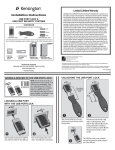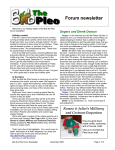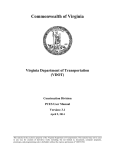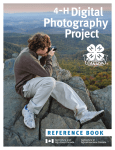Download August 2013 STATE CONFERENCE OCTOBER 18
Transcript
August 2013 STATE CONFERENCE OCTOBER 18-19 from Alycia Crall, VAMN State Coordinator speaker. For any questions about logistics of the conference or registration, please email Tiffany Brown (mailto:[email protected]). We look forward to seeing many of you in October! CONFERENCE REGISTRATION Wyndham Virginia Crosings Hotel & Conference Center Registration is now open for our 2013 Virginia Master Naturalist Statewide Conference! We have a great conference planned with a weekend full of exciting field trips, workshops, and outdoor activities. This year, the conference will be divided between two venues. On Friday evening and all day Saturday (October 18-19), sessions will be at the Wyndham Virginia Crossings Hotel & Conference Center in Glen Allen, Virginia. Sunday (October 20) will include field sessions at Pocahontas State Park, a 45 minute drive from the hotel. Early registration for the conference will be open until August 15. Early registration saves $20 for full conference registration ($155 vice $175) or $10 on Saturday only registration ($110 vice $120 for Saturday training and dinner or $60 vice $70 for Saturday training only). All registration will close September 15. To get additional information and to register: www.regonline.com/2013_vmn_conference Group rates have been set up at the conference hotel, Wyndham Virginia Crossings & Conference Center. Rates are $109 per night for single or double or $119 per night for triple or quadruple occupancy. In order to get these group rates, you must make the reservation by phone and tell them that you are with the “Virginia Master Naturalist 2013 Statewide Conference”. Local in Richmond 804-727-1400 Long Distance 877-999-3223. STATE PHOTO CONFERENCE Pocahontas State Park We also have a special evening planned for Saturday with Dr. Caren Cooper from the Cornell Lab of Ornithology as our guest The State Conference will include a photo competition again this year. Carol Hammer’s first place Flora entry from last year is shown below. The format is changed somewhat this year to include the addition of a “Virginia Other” category along with Flora and Fauna, and judging will be done the first evening of the conference. Because Master Naturalists are so aware of their surroundings, they do tend to have a good “eye” for a picture, and not just as documentation. So, please let us see what you have been seeing, by sending in your pictures. You may feel shy, but don’t be. You may say “Oh it’s not good enough” …. But let us be the judge of that! You may be pleasantly surprised and bring home a ribbon! Carol Hammer's First Place Photo from 2012 Competition NNMN Photo Contest from Cathy Sachs It’s summer so it must be time for our second annual Photo Contest! The Virginia Master Naturalists run a state-wide photography contest, and last year our chapter made quite a good first impression (Thank you Carol Hammer!). We are now gearing up for our second go-round, and I want to invite you to be bold and submit your best work in any of these categories: flora, fauna, or other (landscape, scenic, etc.) We have a rather abbreviated time frame this year, however, and our deadline for submission is August 30th. All the rules and some special tips are in an attachment to this newsletter and separate email, but if you have any unanswered questions, you may contact me, Cathy Sachs, at [email protected]. Our judges this year are Mike Geissinger, Bill Portlock, and yours truly. I wrote last year that photography is an amazingly useful tool for Master Naturalists especially. In addition to our field journals, we so often pull out our camera, whether that is a point-and-shoot or something more sophisticated. And there is nothing wrong with the point-and-shoot, by the way. It is your ability to see that is the most important ingredient here, not the piece of equipment. NNMN Photo Exhibit at the Kinsale Ice Cream Shop Note: This is in addition to and separate from the state’s Master Naturalist Photo Contest which is currently underway. The Northern Neck Chapter will host an exhibit of members’ photos beginning on Saturday, September 21 (Kinsale Days) and continuing until October 25th at the Ice Cream Shop in Kinsale. This is great exposure for our chapter and also gives our talented photographers a display venue. Last year several participants sold some of their photos. All pictures must be received by Wednesday, September 18, when they will be hung at the Ice Cream Shop. To place your photo into the exhibit you will need to: Print and frame your photo (Any frame of your choice works. You do not need to follow state guidelines. Use last year’s frames if you have them.) Make sure that your name, the image title, location where taken and/or species (both common and scientific names if applicable) are included. Artistic interpretations and moderate photoshopping are fine. Show your creativity here. You do not need to follow state contest guidelines, however, we encourage you to frame 2 images that you may have entered in the state contest. Bring your framed photo(s) to any of these events: Tuesday, August 13 to John Narney before or after the Omega Protein Tour Program. Tuesday, September 10 to any Board Member before or after the Paul Billings “Invasives Walk” at Menokin. Friday, September 13 to any Board Member present at the MN Photo Critique at Belle Isle. Wednesday, September 18, bring your framed photos to the Kinsale Ice Cream Shop. The exhibit will be staged and the photos will be hung on September 18. If you cannot deliver the photos at the times and locations listed above, contact John or Pam Narney (804 224 0014) to arrange delivery of your photo(s) (no limit on submissions). BATS IN YOUR BELFRY picture and article by Carol Hammer Sammy Zambon, park ranger at Caledon State Park gave an interesting and informative talk on some of the bats found in our state at a recent meeting of the Master Naturalists. Menokin hosted the event and it was well attended. Chief Ranger Sammy Zambon Sammy covered 7 local bats and explained to us their eating and roosting habits along with many other fun facts. Bats mentioned were the little brown bat, big brown bat, evening bat, silver-haired bat, hoary bat, eastern pipistrelle bat and the eastern red bat. He explained how they used echo location to maneuver and catch their prey, with the sound pulses coming closer together as they near their target. He also explained how many bats are threatened by what is called white nosed syndrome, mostly a threat to those bats that colonize in caves. It is a fungus that develops around the nose and occasionally other parts. This fungus was first recognized in upstate NY in 2006 near Albany. Many bats were found dead on the floor of a cave from this quick devastating disease. It is spread from bat to bat in most instances, but they have found a few cases of human transmittal. It is a cold loving fungus and survives only between 30 and 60 degrees Fahrenheit. Mortality in some caves has been up to 90 percent. It is a relatively new disease and more research is being done. Since most bats only produce one young at a time, it has been hard to repopulate their numbers to cover their losses due to this disease. Some interesting facts learned from the talk: Bats purr like a cat when contented. In general they live a long life, up to 20 years, depending on the species. The little brown bat eats over water; it loves mosquitoes. The big brown bat female will eat her body weight feeding at night on stink bugs and mosquitoes and other insects. The evening bat is almost never found in a cave, usually dwelling in a forest either solitary or in colonies of hollow trees. The silver-haired bat has a patch of silver on its back, hence its name. The hoary bat is Virginia’s largest bat weighing up to 1.4 oz. and has up to a 13 inch wingspan. 3 The eastern pipistrelle bat is highly selective as to where they roost and will return to the same spot for years. The eastern red bat is the prettiest local bat with the coloring of a red fox. To stay warm they will wrap themselves up with their wings and tail and hang looking like a dead leaf. Their body temperature can sustain down to 23 degrees, so there are studies going on relating to this phenomena. Approximately 1 million bats will eat 700 tons of insects a year which is why we should be concerned about losing them to white nose syndrome. NEW APP FROM AUDUBON http://www.hummingbirdsathome.org/ Log on. Sign up. Join in. Download for iPhone Download for Android NOTES FROM CHARLENE Belle Isle Hunt Days Belle Isle State Park will be closed on the following days for managed hunts: Nov 13-14, Belle Isle, deer hunt Dec 16-17, Belle Isle, deer hunt Project Hours at Belle Isle State Park It's never been easier to make a difference for hummingbirds This spring, Audubon launched a high-tech tracking project to monitor hummingbird populations and feeding behavior across the US Download the mobile app or visit the website to report your sightings. The all new version features hundreds of new plants that you can sort by zip-code or color and add to personalized favorites lists for quick selection. Audubon scientists will use the data you submit to map conservation strategies to protect hummingbirds. 1) Weed warriors group: Help maintain gardens at Belle Isle. Bonus: Lots of give-away plants and seeds this year! 2) Someone with sewing skills needed for some of our projects. Materials will be provided. 3) “Under the Bay” project help needed. We will be constructing a portable underwater model to use with school groups and the general public. Help will be needed with construction, painting, and assembly. 4) Help with school groups. Training will be provided to help Charlene with visits to schools this fall and winter. We will also 4 be developing some new STEM (Science, Technology, Engineering and Math) programs for middle school students. Contact [email protected] (804) 462-5030 Web Sites of Interest Nature Blog Network Living Alongside Wildlife wildlife benefits of warm season grasses Advanced Training Opportunities in Forestry 5th Annual Landowner Weekend Retreat Fall Friday September 6 - Sunday September 8 Airfield Conference Center, Wakefield. This program will introduce you to management planning, working with a professional forester, tree identification, using forestry equipment, and much more. -- October 18, Culpeper County, $45/person; $80/couple Working Woods Walk 2 - 4:00 p.m., Sunday October 27 - James Madison's Montpelier. $5 with the purchase of a mansion tour; $10 for the Working Woods Walk alone. This two-hour hike of the Montpelier Demonstration Forest will help visitors understand society's dependence on forests now and during the Madison's time and how to care for our forests today. Contact Adam Downing, 540/948-6881 for more information. MORE FROM WILDBUNCH Contact Jennifer Gagnon 540/231-6391 for more information. Fall Forestry & Wildlife Field Tours Join natural resource professionals and fellow forest landowners for an informative fall day in the woods! We will see forestry & wildlife management practices in action on private, public and industry owned lands. Lunch, refreshments and transportation are all included in the registration fee. -- October 3, Northampton County, $45/person; $80/couple -- October 11, Roanoke County, $45/person; $80/couple -- October 15, Patrick County, $25/person; $40/couple Baby Raccoons picture by Martha Berger A LITTLE HUMOR St Francis Explaining Grass to God GOD: Frank, you know all about gardens and nature. What in the world is going on down there on the planet? What happened to the dandelions, violets, milkweeds and stuff I started eons ago? I had a perfect nomaintenance garden plan. Those plants grow in any type of soil, withstand drought and multiply with abandon. The nectar from the long-lasting 5 blossoms attracts butterflies, honey bees and flocks of songbirds. I expected to see a vast garden of colors by now. But, all see are these green rectangles. ST. FRANCIS: It's the tribes that settled there, Lord, The Suburbanites. They started calling your flowers 'weeds' and went to great lengths to kill them and replace them with grass. GOD: Grass? But, it's so boring. It's not colorful. It doesn't attract butterflies, birds and bees; only grubs and sod worms. It's sensitive to temperatures. Do these Suburbanites really want all that grass growing there? ST. FRANCIS: Apparently so, Lord. They go to great pains to grow it and keep it green. They begin each spring by fertilizing grass and poisoning any other plant that crops up in the lawn. GOD: The spring rains and warm weather probably make grass grow really fast. That must make the Suburbanites happy. ST. FRANCIS: Apparently not, Lord. As soon as it grows a little, they cut it, sometimes twice a week. GOD: They cut it? Do they then bale it like hay? ST. FRANCIS: Not exactly, Lord. Most of them rake it up and put it in bags. GOD: They bag it? Why? Is it a cash crop? Do they sell it? ST. FRANCIS: Yes, Sir GOD: These Suburbanites must be relieved in the summer when we cut back on the rain and turn up the heat. That surely slows the growth and saves them a lot of work. ST. FRANCIS: You aren't going to believe this, Lord. When the grass stops growing so fast, they drag out hoses and pay more money to water it, so they can continue to mow it and pay to get rid of it. GOD: What nonsense. At least they kept some of the trees. That was a sheer stroke of genius, if I do say so myself. The trees grow leaves in the spring to provide beauty and shade in the summer. In the autumn, they fall to the ground and form a natural blanket to keep moisture in the soil and protect the trees and bushes. It's a natural cycle of life. ST. FRANCIS: You better sit down, Lord. The Suburbanites have drawn a new circle. As soon as the leaves fall, they rake them into great piles and pay to have them hauled away. GOD: No!? What do they do to protect the shrub and tree roots in the winter to keep the soil moist and loose? ST. FRANCIS: After throwing away the leaves, they go out and buy something which they call mulch. They haul it home and spread it around in place of the leaves. GOD: And where do they get this mulch? ST. FRANCIS: No, Sir, just the opposite. They pay to throw it away. GOD: Now, let me get this straight. They fertilize grass so it will grow. And, when it does grow, they cut it off and pay to throw it away? ST. FRANCIS: They cut down trees and grind them up to make the mulch. GOD: Enough! I don't want to think about this anymore. St. Catherine, you're in charge of the 6 arts. What movie have you scheduled for us tonight? ST. CATHERINE: 'Dumb and Dumber', Lord. It's a story about... GOD: Never mind, I think I just heard the whole story from St. Francis. position please contact the nominating committee: Gail Sigler [email protected] or Earline Walker mailto:[email protected] Pam UPCOMING ADVANCED TRAINING* FROM THE PRESIDENT By the time this reaches you, there will be only a few days left to save money by taking advantage of early registration for the State Conference in Richmond. The conference provides a great opportunity to get to know Master Naturalists from across the state. Activities include 16 different Advanced Training opportunities on Saturday at the conference site and another eight on Sunday at Pocahontas State Park. Also included are dinners on Friday and Saturday evenings. Compared to last year’s location in Martinsville, Richmond is relatively close. If you can’t make it for the whole conference, you can register for just the Saturday activities. If you attend the entire conference, you can complete either 11 Advanced Training hours or eight Advanced Training hours and three hours of volunteer time with a service project. If you opt for the service project you can count your travel time to and from the conference as volunteer time. Hope to see you there. It is not too early to be thinking about election of next year’s slate of Chapter officers. President, Vice President, Secretary and Treasurer will be elected at the November General Meeting. If you would like to be nominated for one of these offices or know someone you feel would be well suited for the Aug 13 – “NNMN Menhaden Program” 9:30 to 11:30 AM, Omega Protein, Reedville Sept 10 – “Invasives ID Walk” 2:00 to 3:30 PM, Paul Billings, Menokin, Gen Meeting to follow Oct 8 – “Agriculture in the Northern Neck” 10:00 AM to 12:00 PM, Stephanie Romelczyk, Farmer’s Museum Oct 18-20 – “VA MN State Conference” Richmond Nov 3 or 10 – “Bird ID Walk” 8:00, Sandy Spencer, final date and location TBD *For more details, times and locations go to the Event Calendar on the Virginia Master Naturalist Volunteer Management web site. https://virginiamn.volunteersystem.org/users/index .cfm Thanks to Martha Berger, Carol Hammer, Kathy Sachs, Gail Sigler, and Charlene Talcott for their work on this issue. Please send items of interest, advanced training opportunities, news and pictures about your projects, and other newsletter items to [email protected]. 7 MASTER NATURALIST PHOTO COMPETITION SUMMER 2013 Submission rules 1. All entries must be taken by members or trainees in good standing of the NN Master Naturalist Chapter 2. A participant may enter up to five images total in one or other of the following categories: a. Flora b. Fauna c. Other e.g. landscape, scenic 3. All entries must have been photographed in the state of Virginia 4. File size: 500K to 1MB jpg (Or if your software options are just Small, Medium or Large, select Medium. See note *1 below) 5. Modifications not permitted: - No borders or frames may be added to the image - Adding or replacing elements in an images is not permitted - Artistic filters are not permitted 6. Permitted modifications - Images may be cropped, resized, rotated as necessary - Red-eye removal - One-step enhancement (such as Auto-Fix, Quick-Fix, Auto Levels etc.) - Minor use of filters to sharpen, soften, blur, de-speckle - Minor use of corrective functions to improve the natural appearance of the image such as white balance levels, contrast, brightness, curves, intensity, tone, hue, saturation, lightness, value, color balance, de-saturation and tint Send by email to: [email protected] Deadline: Friday August 30th, but please send in your submissions earlier if possible Identify your image see note*2: a. Your name: First initial + Last Name + 4 digit number b. Image Title c. Location d. Category: Flora, Fauna, Other e. Date image was taken f. Species shown in image (both common and scientific) Notes *1 For the purposes of this competition, the above file sizes are appropriate. However, if you are planning on printing your photograph/s later on for exhibition, use the largest format on your camera *2 This information can be added to the metadata that is automatically embedded in the actual image. If you do not know how to do this, please supply the information with your emailed entry, and we can add that for you 8 Hints on How to Take a Good Photograph Ask yourself: what is the subject of this image? Is the foreground important? What does the background add to the composition? Is there anything in the viewfinder that is distracting from the main subject? Adjust your depth of field appropriately (check your user’s manual for tips on how to do this). Better yet, take several images with different depths of fields or exposures, so that you can judge the differences (but be sure to take notes so that you know what you did!) Get rid of extraneous details, either through the lens or by cropping You may have heard of the “Rule of Thirds” but treat it as a guideline not a hard and fast Rule. If you imagine a tic-tac-toe grid over your image, the main subject/s usually look best when placed on these lines or intersections of lines. This will normally produce a more balanced image …. But don’t let your own creativity hold you back from experimenting with placement Other composition tips: Horizons? Keep them straight unless there is an artistic reason not to do so Close ups (whether flora or fauna) need to be really sharp (again unless there is an artistic reason not to do so). Use a tripod if necessary Be conscious of “framing” the image when appropriate so that the viewer’s eye is drawn to the subject Beware of harsh light (e.g. midday) but if that is when you have to shoot, then see how you can soften it (again, check your user’s manual) Where is the light source for your subject? Take advantage of back lighting to achieve great effects, even silhouettes Move! This is so important especially with nature photography. More than likely you cannot move your subject, whether that is a natural scene, insect etc. So you must move yourself to take a better photograph. For example: Get in close, shoot from above or below, lie on the ground etc. Move along the trail, to avoid the distraction of over-hanging branches Judging Judging will be done by three judges: Bill Portlock, Mike Geissinger and Cathy Sachs A live critique will take place in early September, with the finalists being announced The first place winning photograph in each category will be framed and presented at the Virginia Master Naturalist Statewide Volunteer Conference in October Questions? Contact Cathy Sachs at [email protected] 9






























